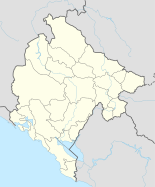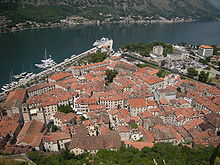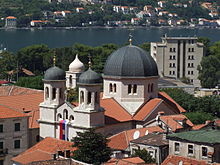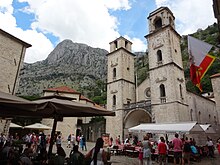Kotor
|
Kotor Котор |
||||
|
||||
| Basic data | ||||
|---|---|---|---|---|
| State : |
|
|||
| Municipality : | Kotor | |||
| Coordinates : | 42 ° 26 ' N , 18 ° 46' E | |||
| Height : | 0 m. i. J. | |||
| Area : | 335 km² | |||
| Residents : | 23,500 (2003) | |||
| Population density : | 70 inhabitants per km² | |||
| Telephone code : | (+382) 32 | |||
| Postal code : | 85330 | |||
| License plate : | KO | |||
| Others | ||||
| Patron saint : | St. Tryphon | |||
Kotor ( Montenegrin - Cyrillic Котор , Italian Cattaro , Latin Acruvium ) is an old Mediterranean trading and port city and national cultural center at the southeast end of the Bay of Kotor ( Adriatic Sea ) in the municipality of the same name in Montenegro . According to the 2003 census, it had 5341 inhabitants (with Dobrota together 13,510), the 335 km² community (including the 13 surrounding settlements) had 22,947 inhabitants.
The city with its important cultural and historical buildings and its location was included in the UNESCO World Heritage Site in 1979. It is the seat of the Catholic diocese of Kotor and the center of the Serbian Orthodox Christians of Montenegro. The city and the deep bay framed by mountain ranges ( Orjen and Lovćen ) up to 1894 meters high are the most famous and most visited tourist region in the country. It houses the nautical and tourism and hotel management faculties of the University of Montenegro .
Risan , Perast , Dobrota , Orahovac and Dub belong to the municipality .
history
The natural harbor offered cheap protection, which was already in the 3rd century BC. It attracted the Illyrians , who were later followed by Greeks and Romans . In 168 BC Kotor was mentioned as Ascrivium ; Roman colonization began at that time. During the imperial era, the city first belonged to the province of Dalmatia . Emperor Diocletian assigned Kotor to the newly formed province of Praevalitana at the end of the 3rd century .
In response to the Great Migration , Kotor was heavily fortified in Byzantine times. First, Emperor Justinian had a fortress built at Ascrivium in 535. In 840 the city was sacked by a Saracen fleet . In 1242 the city was destroyed again, this time in the Mongol storm .
In the 14th century, Kotor had played such a big role in the Adriatic Sea trade that it came into competition with Venice and the Republic of Ragusa ( Dubrovnik ). When the Serbian Empire , to which Kotor belonged for almost 200 years, collapsed after Tsar Dušan's death (1355) , the Venetians attacked the city in 1369, conquered and destroyed it. After a short Hungarian and Bosnian membership, Kotor became an independent republic in 1391. During this time she often had to fight out arguments with the Balšići . In 1420 the city placed itself under Venetian protection and lost more and more of its independence. The Provveditore for Venetian Albania had its seat in Kotor since the 16th century . In 1564 many buildings in Kotor were damaged by a severe earthquake. In the 1667 earthquake , more than half of all buildings were destroyed or damaged.
After the fall of the Republic of Venice in 1797 , the city was awarded to Austria in the Peace of Campo Formio . From 1805 to 1814 the area was occupied by France. From 1815 Kotor was a district town in the Austrian crown land of Dalmatia . The Austrians expanded the port into a base for the Austro- Hungarian Navy and stationed the IV Battalion of the Hungarian Infantry Regiment No. 33 there.
During the First World War , the Austrian submarines and ships (mostly outdated ships of the line of the pre- Dreadnought era) were in the bay. From February 1st to 3rd, 1918, the Cattaro sailors revolt here by sailors from the mostly inactive fleet. The sailors' uprising was one of the first signs of the collapse of the Central Powers . Moreover, it was a politically highly explosive precedent, which reflected the revolutionary mood in Western Europe after the victory of the Bolsheviks . 6000 sailors on 40 ships of the Austro-Hungarian navy took part in the uprising; they started raising red flags on February 1st . The sailors disarmed the officers and formed sailors' councils. After the violent suppression, the ringleaders of the uprising were shot dead on February 11, 1918 near Cattaro. Today a memorial plaque in the fortress indicates Frantisek Ras (Franz Rasch), Jeroko Sizgoric, Mate Brnicevic and Anton Grubar. In German-language literature, the uprising is best known for the play The Sailors of Cattaro by the playwright Friedrich Wolf .
In 1918 Kotor came to the Kingdom of Yugoslavia . Even in the Yugoslav period, especially in socialist Yugoslavia , Kotor was an important naval port. With the dissolution of the military following the declaration of independence from Montenegro in 2006, all military facilities were given up.
Since then, many cruise ships have docked in Kotor. Most only stay a few hours, others a night.
population
structure
At the 2011 census, the municipality of Kotor had 22,601 inhabitants, of which 11,047 (48.88%) identified themselves as Montenegrins , 6,910 (30.57%) as Serbs and 1,553 (6.87%) as Croatians . Other smaller population groups also live in the community. The Italian part of the population (since the 19th century about 1/3 of the total population) had to leave the area after the Second World War .
sons and daughters of the town
- Eugen Gelcich (1854–1915), Austrian nautical instructor
- Josef Venantius von Wöss (1863–1943), Austrian composer
- Radola Gajda (1892–1948), Czechoslovak officer
- Viktor Vida (1913–1960), Croatian writer
- Nikë Prela (1918–1996), Roman Catholic bishop
- Vasko Lipovac (1931–2006), Croatian painter and sculptor
- Larry Vuckovich (* 1936), American jazz musician
- Branko Sbutega (1952-2006), Catholic priest, human rights and peace activist
- Svetozar Marović (* 1955), first President of Serbia and Montenegro
- Rambo Amadeus (* 1963), singer and composer
- Goran Stojanović (* 1966), former handball goalkeeper
Attractions
| Scenic and cultural and historical region of Kotor | |
|---|---|
|
UNESCO world heritage |
|

|
|
| National territory: |
|
| Type: | Culture |
| Criteria : | i, ii, iii, iv |
| Reference No .: | 125 |
| UNESCO region : | Europe and North America |
| History of enrollment | |
| Enrollment: | 1979 ( session 3 ) |
Kotor is famous for its medieval old town surrounded by an impressive 4.5 km long city wall. One of the famous buildings is the Romanesque Saint Tryphon Cathedral ('Sveti Trifun') in the city center, where the relics of the city's patron saint, Saint Tryphon , are kept. It is considered to be the most beautiful church in Montenegro. The oldest part of the church dates back to 1166, with the formative face and towers being rebuilt after the earthquake of 1667 .
Other structures are the single-nave Romanesque St. Luke Church (1195), which went to the Orthodox Church in the 17th century, and the clock tower in the Renaissance style (1602) at the main square of the old town. Under Venetian rule, some palaces were built in the 15th to 18th centuries, which still shape the cityscape today. On the slopes of the Bay of Kotor, the defensive structures, which are up to 15 meters wide and 20 meters high, extend over 4.5 kilometers up to a height of 260 meters on Mount San Giovanni.
UNESCO world heritage
In April and May 1979, shortly before it was added to the UNESCO World Heritage List, Kotor was badly damaged in two strong earthquakes . As a result, UNESCO put it on its so-called Red List of World Heritage in Danger in the same year . Until 1989 a lot could be rebuilt with international help. In the 1990s, Kotor's status as a world heritage site was threatened by uncontrolled construction work. At the beginning of 2003, after taking stock of the situation, experts recommended that it be removed from the Red List on the condition that an overall concept be drawn up that solves problems. The German World Heritage Foundation then initiated a round table in November 2003 with the result that a comprehensive concept had been drawn up by the end of 2006, which the national authorities supported. The foundation cooperates with the regional institute for the protection of cultural heritage and raises funds.
Twin cities
- Kehl , Germany , since 2000
- Nessebar , Bulgaria
- Santa Barbara , California, USA , since 2010
- Szeged , Hungary
- Xi'an , People's Republic of China , since 2013
literature
- Ilija Sindik: Komunalno uređene Kotora. Od druge polovine XII do početka XV stoleca (= Posebna izdanja 165 = Posebna izdanja. Istoriski Institut 1, ZDB -ID 1111974-3 ). Naučna Knjiga, Beograd 1950.
Web links
- History and tourist information about Kotor (English)
- Information about Kotor (English) as part of the "New Economic Geography" map of the European Stability Initiative (ESI)
Individual evidence
- ↑ Paola Albini: The Great 1667 Dalmatia Earthquake: An In-Depth Case Study. Springer, Cham / Heidelberg / New York / Dortrecht / London 2015, ISBN 978-3-319-16208-9 , pp. 69–71.
- ↑ Simon Loidl: "We were free for two and a half days." On the literary and political reception of the sailors' uprising at Cattaro in Austria. In: Year Book for Research on the History of the Labor Movement , Volume III / 2014, pp. 131–152.
- ^ Rheinische Post , February 22, 2012, p. B5.
- ^ Sister Cities. Santa Barbara, accessed June 20, 2017 .
- ^ Sister Cities. ( Memento of the original from October 24, 2016 in the Internet Archive ) Info: The archive link was inserted automatically and has not yet been checked. Please check the original and archive link according to the instructions and then remove this notice. Website of Xi'an Municipal People's Government.







